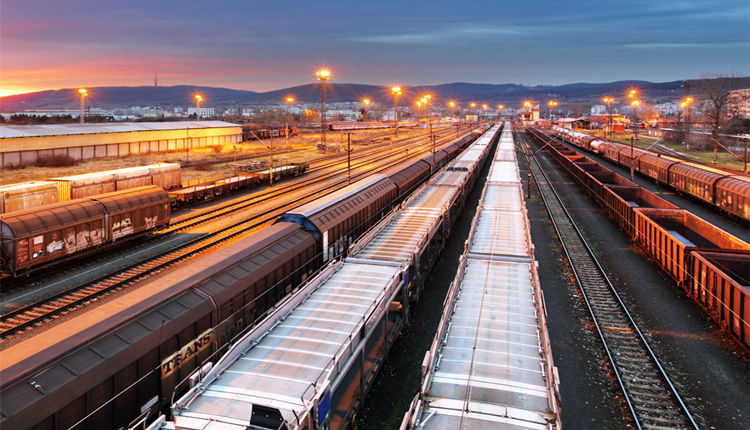Railway Freight Service
Railway Freight Service provides a reliable, cost-efficient, and environmentally friendly way to transport large amounts of cargo over land, with extensive networks, regular schedules, and the ability to handle various types of goods for both domestic and international trade.
Railway Freight from China to Europe
Domestic Railway Transport
Domestic Railway Transport by Jing Logistics offers a dependable, economical, and eco-friendly solution for moving goods within the country, leveraging an extensive rail network, reliable schedules, and professional handling to ensure seamless transit and delivery.

China-Europe International Railway Transport
Jing Logistics’ China-Europe International Railway Transport provides a fast, reliable, and cost-effective link between China and Europe, facilitating trade with efficient cargo handling, regular schedules, and a seamless end-to-end service, strengthening economic cooperation across continents.

China-Vietnam Railway

Railway freight routes from China to Europe
The China-Europe Express mainly lays out three channels: West, Central and East:
- Western Channel: Starting from the central and western regions of the country, exiting through the Alashankou (or Horgos) port, passing through Kazakhstan, Russia, Belarus, Poland, Germany and other countries, and finally reaching various parts of Europe.
- Central Channel: Starting from the North China region of the country, exiting through the Erenhot port, entering Mongolia and heading to Europe.
- Eastern Channel: Starting from the northeast region of China, exiting through the Manchuria (or Suifenhe) port, entering the Russian Trans-Siberian Railway and heading to Europe.
Specific routes include Changsha to Duisburg, Germany, Yiwu to Madrid, Spain, Harbin to Russia, etc. These routes cover a wide range of European regions and provide convenient logistics services for customers in different regions.
| Origin (China) | Destination (Europe) | Key Transit Points |
|---|---|---|
| Chongqing | Duisburg (Germany) | Kazakhstan, Russia, Belarus |
| Chengdu | Lodz (Poland) | Kazakhstan, Russia, Belarus |
| Zhengzhou | Hamburg (Germany) | Kazakhstan, Russia, Belarus |
| Yiwu | Madrid (Spain) | Kazakhstan, Russia, Belarus, France |
| Wuhan | Pardubice (Czech Republic) | Kazakhstan, Russia, Belarus |
| Suzhou | Warsaw (Poland) | Kazakhstan, Russia, Belarus |

Rail freight time from China to Europe
The transportation time of China-Europe Express varies depending on the route. Generally speaking, the transportation time from China to Europe is between 15 and 20 days. Although in theory some routes have shorter operation times, in actual operation, due to the existence of track changes, inspections and other links, the actual transportation time may be slightly longer.
| Origin (China) | Destination (Europe) | Approximate Transit Time |
|---|---|---|
| Chongqing | Duisburg (Germany) | 16-18 days |
| Chengdu | Lodz (Poland) | 17-19 days |
| Zhengzhou | Hamburg (Germany) | 18-20 days |
| Yiwu | Madrid (Spain) | 18-21 days |
| Wuhan | Pardubice (Czech) | 17-20 days |
| Suzhou | Warsaw (Poland) | 16-19 days |
International Railway Transport Advantages
International Railway Transport Advantages include cost-efficiency for bulky cargo, reliable schedules, reduced transit times compared to some modes, environmental friendliness, and the ability to connect major economic regions for enhanced global trade.
Speed
It is by far the fastest mode of transportation for long distances. You can reach destinations on the other side of the world in a matter of hours.

Global Reach
Air transport connects almost every major city and country in the world. No matter where you are or where you want to go, there is likely an air route available.

Reliability
Airlines operate on strict schedules, providing a high degree of reliability. You can plan your trips or shipments with confidence, knowing that there is a good chance of the flight departing and arriving on time.

Safety
The aviation industry has stringent safety standards and regulations. Airlines invest heavily in safety equipment, training, and maintenance to ensure the safety of passengers and crew.

Capacity
Large cargo aircraft can carry significant amounts of freight. This is essential for transporting high-value and perishable goods, as well as for meeting the demands of global supply chains.

Wide Coverage
It can reach destinations all over the world, including remote areas. This wide coverage enables it to meet a variety of international trade and logistics needs.
More Shipping Options
Our air freight advantage lies in rapid transit times, high – security handling, extensive global network connections, real – time cargo tracking, and customized solutions for diverse shipping needs.
Customer Review
Explore honest customer reviews of Jing Logistics. to see why they’re a trusted leader in freight and logistics services.






Shipping by Rail Freight: FAQs Answered
You can ship just about anything by rail. In fact, it’s probably easier to cover what you can’t ship first. It’s a short list: personal property, passengers, pets and other living things.
What you can ship is a much, much longer list: Think raw materials to finished goods and everything in between. Here are just a few examples:
- Raw Materials: Sand, plastic pellets, soda ash, rock, fibers, minerals
- Building Materials and Component Parts: Auto parts, lumber, pipe, metals, paper, rebar, metal coil, cement
- Fuel: Ethanol, biodiesel, gasoline, petroleum, propane, coal
- Food and Beverages: Packaged food, canned goods, frozen food, produce, seafood, cheese, chocolate, meat, grain, feed products, corn syrup, beer, wine, tequila, orange juice
- Finished Goods: Shoes, clothing, toys, furniture, appliances, electronics, automobiles, machinery, military vehicles, irrigation equipment, paper, solar panels
The short answer: If you have large quantities of goods to ship, you can probably move them by rail.
You can ship products by rail pretty much anywhere in North America. Between the major railroads that operate in Canada, the United States and Mexico and smaller railroads in between, railroad tracks span the continent. Factor in ocean carriers and you can use rail to ship to virtually any destination worldwide.
Class I Railroads are the companies that operate the major rail lines – if you compared it to U.S. roadways, their tracks would be the interstates of the rail network. The United States has five Class I Railroads. While each company owns its own network of tracks, they do interchange traffic with each other, which means you can ship coast to coast, even if it involves more than one railroad. These railroads also interchange traffic with railroads in Canada and Mexico, giving you access across the borders, too.
Short line railroads operate in more localized areas. Although they have “shorter lines” than Class I Railroads, they provide important connections in areas where the big players don’t have tracks.
If you import or export products, rail is still an option. Railroads have access to ports, allowing products to be shipped to and from global markets.
The short answer: Anywhere in North America, whether coast-to-coast or across the border.
If you don’t have tracks where you’re shipping from or to, there are still ways to connect to rail. Two processes – intermodal shipping and transloading – allow products to move seamlessly between trucks and trains and back again.
Let’s say the facility from which you’re shipping isn’t rail served. Trucks can pick up your products, deliver them to a transload facility or intermodal ramp, then transfer them to a train. If the destination doesn’t have tracks, either, your products can be transferred back to trucks for final delivery.
Shippers use intermodal shipping and transloading so they can take advantage of the economic benefits of shipping by rail. By combining shipping modes, you get the flexibility of over-the-road trucking and the affordability of long-haul rail shipping, all without an investment in tracks.
The short answer: Thanks to transloading and intermodal shipping, products can be transferred between trucks and trains, which means neither the origin nor destination needs to have tracks.
Why do people seek out rail? In short, it offers some major advantages:
Capacity for large amounts of cargo
Greater efficiency compared to truck, especially for long-haul moves
Lower cost per ton mile
What benefits do these features offer shippers?
Market Reach: With the rail network spanning North America, you can ship to distant markets more affordably.
Scalability: Rail can accommodate small shipments (called “less-than-carload” shipments), very large shipments, and everything in between. You can even ship large, oversized freight like heavy machinery and wind turbines by rail.
Reliability: Rail is a 24/7 operation.
Sustainability: Shipping by train is the most fuel efficient and environmentally responsible mode of ground freight transportation.
Cost Savings: Rail is almost always a more affordable transportation solution than truck, especially for long-haul shipments.
The short answer: Rail offers a safe, green and economical way to ship a large amount of goods.
Why Choose Us
We find delight in providing comprehensive and professional freight forwarding services for easing you supply chain needs
Expertise and Experience
We have decades of experience in international freight shipping. Our team of professionals has successfully navigated complex logistical challenges, handling shipments to and from various countries.
Comprehensive Service Offerings
Our services cover a wide range of freight options, including air freight for time-sensitive shipments, ocean freight for large volumes, and land-based transportation for regional deliveries.
Reliable and Timely Delivery
We pride ourselves on our on-time delivery record. With a well-established network of carriers and partners, we can plan the most efficient shipping routes.
Competitive Pricing
We offer cost-effective shipping solutions without compromising on quality. Our strong relationships with shipping lines and airlines enable us to negotiate favorable rates.





